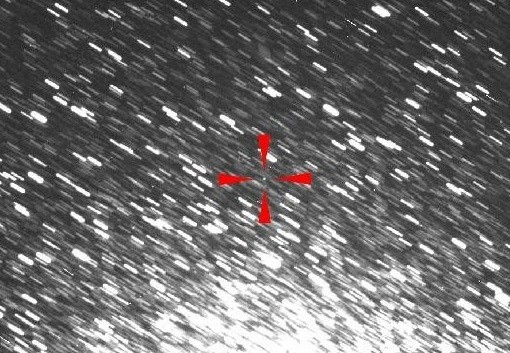After Russia Meteor, Here Comes 2012 DA14 Asteroid [FIRST PICTURES]

Earth gets another close encounter with flying space rock when asteroid 2012 da14 whizzes past our planet later - hours after a meteor burned up over the Urals in Russia.
At just 17,000 miles away, the 50-metre wide extra-terrestrial lump is set to come closer than many satellites orbiting earth which power GPS tracking devices.
An amateur astronomer in Australia snapped a glimpse of 2012 DA14 gets closer and closer on its journey through space. Dave Herald snapped it with his camera from 770,000 miles away.
It will pass just hours after stunning footage recorded a burning meteor lighting up the evening sky over the Urals in Russia.
Windows smashed and explosions were heard as the meteor entered the atmosphere and disintegrated in dramatic scenes, leaving more than 400 people injured.
Stunned bystanders fled for cover from the meteor which turned night into day with its burning intensity.
NASA experts moved to quell fears over 2012 DA14, which was discovered last year.
Dr Don Yeomans said: "We know exactly where it's going to go, and it cannot hit the Earth."
However, a devastating impact by 2012 DA14 cannot be ruled out completely. The odds of it happening later at around 7.30pm GMT are one in seven billions, according to calculations.
The best place on earth to see 2012 DA14 will be Indonesia. Spotters in Australia, Asia and southern Europe should also be able to catch a glimpse of the asteroid by using binoculars.
2012 DA14 promises nothing so spectacular as the Russian Urals meteor. But it will come closer than to earth any other asteroid - making it the nearest miss in years.
However, it will remain an asteroid by not entering the earth's atmosphere. Meteors are created when asteroids are dragged into earth's orbit and fall to the ground, or burn up in the sky.
Gravity force will tug the Martian asteroid toward earth, increasing its speed. But its trajectory shall keep it at a safe distance. However, 2012 DA14 will be affected byits brush with earth's gravity. It's orbit around the sun will be cut by 51 days.
The last time an asteroid of a similar sized to 2012 DA14 hit earth was 50,000 years and the impact completely destroyed everything within a 50 mile radius. The crash site in Arizona, the United States, is today named the Meteor Crater. That pre-historic rock was made of metal, whereas this new rock is stone, believe experts.
In 1908, another similar sized object entered the atmosphere and then exploded in the sky over Tunguska, in Russia. Trees were flattened for 820 miles around the site.
© Copyright IBTimes 2025. All rights reserved.






















